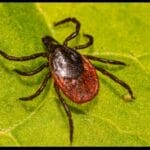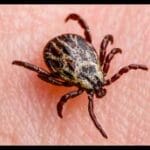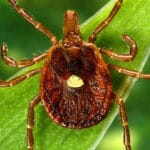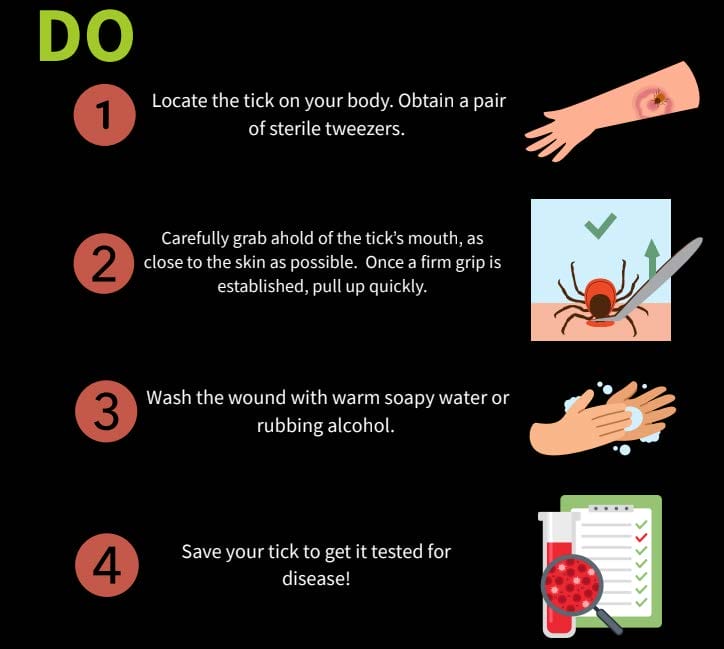let’s talk ticks
October 23, 2025
Gulf Coast tick, photo courtesy of Commonwealth of PA, Dept. of Environmental Protection
by Ayaan Naik, Youth in Public Health, Downingtown STEM Academy
Exploring the beautiful nature preserves, parks, and trails of Pennsylvania gives us the wonderful opportunity to connect with the natural world. But whether you’re walking your dog through trails or hiking in the deep woods, the natural beauty of Pennsylvania brings with it unseen risk: ticks. Being mindful and aware during outdoor excursions is the best way to enjoy the outdoors Lyme free.
what are ticks?

blacklegged tick, image courtesy of Commonwealth of PA Dept of Environmental Protection
Ticks are tiny arachnids (the same family as scorpions and spiders) that are commonly found in tall grasses, shrubs, or wooded areas. They are parasites, latching onto warm-blooded creatures to feed on their blood. What makes ticks really dangerous isn’t their bite but rather the diseases they can transmit.
The blacklegged tick (also known as the deer tick) transmits the most common tick-borne disease in Pennsylvania: Lyme disease. Lyme disease causes flu-like symptoms such as fever and fatigue. While treatable if caught early, long term affliction can lead to irreversible arthritis, nerve pain, memory issues, paralysis, and much more.
ticks and Lyme in Chester County
Out of all 67 Pennsylvania counties, Chester County consistently ranks at the top for Lyme disease prevalence. In 2022, the last major tick survey, the county ranked third for all state Lyme

American dog tick, photo courtesy of Commonwealth of PA, Dept of Environmental Protection
disease cases. In fact, Chester County has more than twice the Lyme incidence than Pennsylvania overall.
Across the Commonwealth, more than 10,000 cases of Lyme disease are reported every year. An estimated one in every four nymph ticks have Lyme disease.
different tick species in PA
- Blacklegged Ticks
– Identifiable by black abdomen, brown color, black legs
– Most common PA
– Same size as a sesame seed - American Dog Ticks
– Identifiable by white or gray markings, reddish brown color
– Spreads Rocky Mountain Spotted Fever and Tularemia
– Largest tick - Lone Star Tick
– Identifiable by reddish brown coloring, white spot on adult females
– One of the smallest ticks
– Transmists Tularemia, Heartland virus, Alpha Gal Syndrome - Gulf Coast Tick
– Identifiable by orange coloring and legs, white abdomen
– Lives in hotter environments
– Not as common in PA
tick prevention

Lonestar tick, photo courtesy of Commonwealth of PA, Dept of Environmental Protection
Utilizing 0.5% Permethrin on clothing is particularly effective as it wards off insects through multiple washes. However, it is very dangerous to small animals and pets, and should not be applied to skin, only clothes.
Natural repellants like lemon eucalyptus oil may also help repel ticks.
Always remember to do regular checks whenever possible. White or light-colored clothing makes ticks easier to spot.
If you find a tick embedded in your skin or on your pet, remove it with tweezers. Removing ticks with your hands leads to greater infection risk. Instead follow the steps provided below:

By educating ourselves and others, we can continue to enjoy our region’s natural beauty while staying safe from ticks.

Photo courtesy of Ayaan Naik
Ayaan Naik is a student at Downingtown STEM Academy and a Coca Cola Scholarship semi-finalist for public health initiatives in Philadelphia. He received the HoulaHelper Congressional Award and is working toward Eagle Scout for various public health initiatives involving AED health, tick awareness, and eyesight health in Pennsylvania. He is interested in infectious disease and epidemiology, and advocates for greater tick and Lyme disease awareness with public health and policy offices across Pennsylvania.
next post
adding to forests in Bucks County
October 23, 2025
FOR IMMEDIATE RELEASE MEDIA, Pa., October 23, 2025 – Natural Lands announced today the permanent preservation of two wooded properties in Haycock and Nockamixon Townships, […]
continue reading